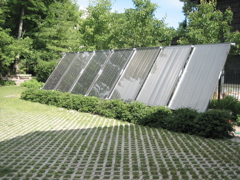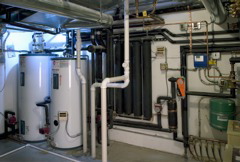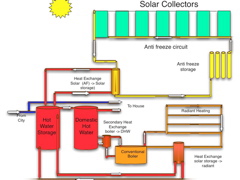
HEATING
Heating and cooling are the largest sources of energy consumption in a home, accounting for as much as half of total home energy use. Roughly 32 percent of the energy bill for a typical house goes to heating indoor spaces, with cooling accounting for another 13 percent (and significantly more for homes in hotter climates). Water heating is also a large energy user, taking roughly 19 percent of the typical home energy bill.In this house, tight construction coupled with high performance windows help reduce heating and cooling needs, and water-efficient fixtures and appliances help reduce the demand for hot water. The use of new technologies--an active solar heating system and an advanced combustion fireplace--reduce energy consumption still further. And low-tech practices such as turning down the temperature on the hot water heater and using multiple heating/cooling zones with programmable thermostats for each yield additional energy savings.
CONTENTS
|
Active Solar Heating System
 An active solar heating system installed by Solar Service Inc is the primary source of heat for domestic hot water. It is a secondary source of heat for the return water of the radiant floor heating system.
An active solar heating system installed by Solar Service Inc is the primary source of heat for domestic hot water. It is a secondary source of heat for the return water of the radiant floor heating system.
Seven 4'x8' solar collectors installed along the driveway are covered with tempered glass to capture the heat of the sun. When the collectors are hotter than the water in the solar storage tank in the basement, the system switches on, and an anti-freeze solution is heated as it is pumped through copper tubes in the collectors. Additional heating is provided by natural gas. The solar collectors produce 500-1,000 BTU/sq.ft./day, depending on the amount of sunlight that day. With seven collectors, the array produces roughly 100,000-200,000 BTU/day, the equivalent of 1-2 therms of natural gas/day. The Illinois Department of Commerce and Community Affairs (now called the Department of Commerce and Economic Opportunity) contributed $5,000 towards the cost of the system through its Renewable Energy Resources Program. (The maximum rebate amount has now been increased to $10,000.) Radiant Heating System
Two ENERGY STAR-certified Weil-McClain GV Gold (Series 4) boilers serve as the primary heat source for the system. Although relatively small by some standards, they are over-sized for this house, given its tight construction and the homeowners' energy-conscious lifestyle and practices. (Each boiler consumes up to 105,000 BTU/hour to generate up to 92,000 BTU/hour.) According to the American Council for an Energy-Efficient Economy, many heating and cooling systems are not properly sized. Unfortunately, that was the case for this house. Despite the homeowners' oft-stated assurance that the house would be exceptionally air tight and energy efficient and despite repeated questioning about the size of the proposed heating and cooling system, the HVAC contractor maintained that the system was sized appropriately. When the contractor finally provided a copy of his calculations (long after the over-sized ducts and boilers were in place), it was clear that the unique features of this house had not received careful consideration. In addition to the size of the house, key factors for correctly sizing a heating and cooling system include:
Advanced Combustion Wood Fireplace
Moreover, the poor combustion in these fireplaces allows large volumes of unburned compounds to go up the chimney or even spill into the house. These incomplete combustion products become creosote, which can cause chimney fires, and also turn into fine particles and toxic pollutants, which are a major source of air pollution and can compromise indoor air quality.
The use of two combustion zones reduces emissions of incomplete combustion products ten-fold compared to a conventional fireplace. In addition, the low levels of incomplete combustion products and creosote virtually eliminate the potential for chimney fires. Other design features contribute to the high performance of these fireplaces. Outside air is brought into the firebox for combustion via an insulated air duct. Indoor air is heated as it is drawn in through a grille under the firebox and moves through a heat exchanger before being sent back into the room through grilles at the top of the fireplace. Truly airtight, gasketed doors prevent room air from being drawn up the chimney, and a special ceramic glass window allows most of the infrared heat from the flame to be transmitted into the room. The unit installed in the living room of this house is an RSF Onyx Fireplace. With an EPA rating of 3.8 grams of particulate matter/hour, it is certified to the same standards as the best freestanding wood stoves. It supplements the radiant floor heating during the colder months, raising the temperature of the house several degrees above the thermostat settings of 65-68 degrees for the different zones in the house. The firewood that the owners burn comes from a local landscaper. Wood burning and the environment
Although carbon makes up about half the weight of firewood and is released as carbon dioxide when the wood is burned, this is part of the natural carbon cycle of trees. As they grow, trees absorb carbon dioxide from the air and store it in the wood as carbon. When a tree dies and decays on the forest floor, it slowly releases carbon dioxide back in the atmosphere; if the tree is burned as firewood instead, the same amount of carbon dioxide is released. In both cases, the carbon dioxide is absorbed again by young trees, and the carbon cycle is repeated, again and again--without increasing atmospheric carbon. Key to the sustainable use of this renewable fuel is to ensure that our forests are well-managed and that the firewood we burn comes from trees that are harvested using sustainable forestry practices. And using an efficient, clean-burning appliance, such as the advanced combustion fireplace discussed above, also helps make heating with wood a good choice for the environment. Links and Resources
|
Website prepared by Eleanor Revelle.
Last revised: February 2014

